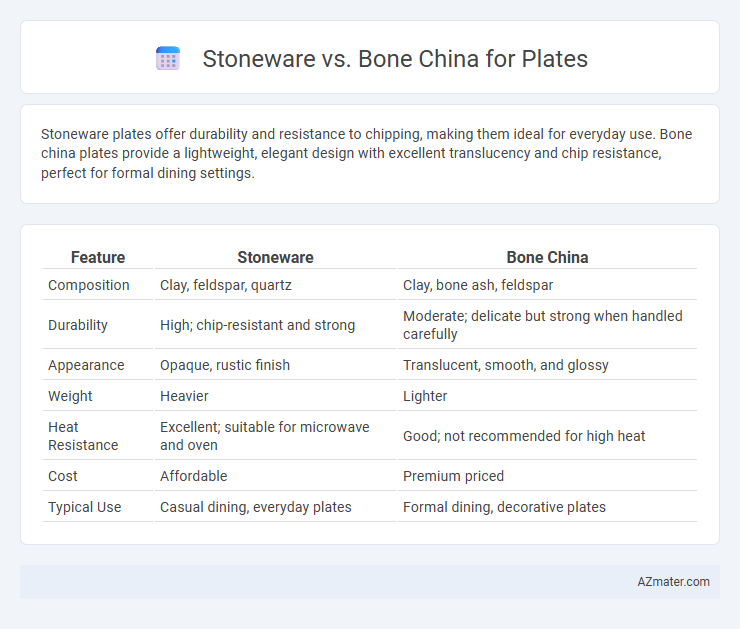Stoneware plates offer durability and resistance to chipping, making them ideal for everyday use. Bone china plates provide a lightweight, elegant design with excellent translucency and chip resistance, perfect for formal dining settings.
Table of Comparison
| Feature | Stoneware | Bone China |
|---|---|---|
| Composition | Clay, feldspar, quartz | Clay, bone ash, feldspar |
| Durability | High; chip-resistant and strong | Moderate; delicate but strong when handled carefully |
| Appearance | Opaque, rustic finish | Translucent, smooth, and glossy |
| Weight | Heavier | Lighter |
| Heat Resistance | Excellent; suitable for microwave and oven | Good; not recommended for high heat |
| Cost | Affordable | Premium priced |
| Typical Use | Casual dining, everyday plates | Formal dining, decorative plates |
Introduction to Stoneware and Bone China Plates
Stoneware plates are known for their durability and rustic appearance, made from dense clay fired at high temperatures for strength and chip resistance. Bone china plates, composed of bone ash, kaolin, and feldspar, offer a lightweight yet strong option with a translucent, elegant finish favored for fine dining. Both materials provide distinct advantages, with stoneware excelling in everyday use and bone china delivering sophistication and delicate aesthetics.
Material Composition: What Sets Stoneware and Bone China Apart
Stoneware is crafted from dense, non-porous clay fired at high temperatures, resulting in a durable and rustic finish, while bone china incorporates bone ash, kaolin, and feldspathic material, giving it a translucent, lightweight, yet strong quality. The high calcium phosphate content in bone china enhances its whiteness and chip resistance, distinguishing it from the heavier, more opaque stoneware. These material differences influence not only the aesthetic appeal but also the durability and thermal properties of each type of plate.
Durability and Strength: Which Plate Lasts Longer?
Stoneware plates are known for their exceptional durability and resistance to chipping due to their dense, vitrified composition, making them ideal for everyday use and long-lasting performance. Bone china plates, while elegant and lightweight, offer impressive strength for fine dining but are more prone to delicate handling and potential chipping compared to stoneware. When prioritizing longevity and resilience, stoneware plates generally outlast bone china in terms of durability and resistance to everyday wear.
Aesthetic Appeal: Comparing Looks and Finishes
Stoneware plates showcase a rustic and earthy aesthetic with a matte or slightly textured finish, emphasizing natural tones and handcrafted imperfections. Bone China plates offer a delicate, translucent appearance with a smooth, glossy glaze that highlights intricate patterns and a refined elegance. The choice between stoneware and bone china hinges on whether one prefers a robust, artisanal look or a sophisticated, polished presentation.
Weight and Thickness: Handling and Usability Differences
Stoneware plates are generally heavier and thicker, offering a sturdy and durable feel ideal for casual dining, while bone china plates tend to be lighter and thinner, providing elegance and ease of handling. The weight of stoneware can make it more stable on the table but less comfortable for prolonged holding, whereas bone china's lightweight design enhances user experience, especially in formal settings. Thickness affects heat retention, with stoneware maintaining warmth longer, and bone china cooling faster due to its slender profile.
Heat Retention and Microwave Safety
Stoneware plates excel in heat retention due to their dense, porous composition, keeping food warmer for longer periods compared to bone china. Bone china, prized for its delicate appearance and lightweight feel, generally has lower heat retention but is typically safe for microwave use because of its vitrified finish. Stoneware may absorb heat unevenly and sometimes resists microwaving, making bone china a more reliable option for consistent microwave safety.
Cost and Value: Price Differences Between Stoneware and Bone China
Stoneware plates are generally more affordable, making them a popular choice for everyday use due to their durability and heavier weight. Bone china plates, while more expensive, offer a refined aesthetic and translucency that justifies their higher price through elegance and long-lasting quality. The cost difference is influenced by materials, production processes, and perceived value, with bone china catering to formal dining and stoneware suited for casual settings.
Maintenance: Cleaning and Care Requirements
Stoneware plates require gentle cleaning with mild detergents and soft sponges to prevent surface scratches, avoiding harsh abrasives that can damage the glaze. Bone china demands careful handling due to its delicate composition, best cleaned with warm water and non-abrasive cloths, while dishwasher use is generally safe but should be avoided for older or hand-painted pieces. Both materials benefit from prompt drying to prevent water spots and maintain their aesthetic appeal over time.
Eco-friendliness and Sustainability Factors
Stoneware plates are generally more eco-friendly due to their natural clay composition and lower energy requirements during firing compared to bone china, which involves animal-derived bone ash and higher kiln temperatures. Stoneware's durability reduces the need for frequent replacement, enhancing sustainability by minimizing waste. Bone china, while appreciated for its translucency and strength, relies on animal by-products and more resource-intensive production, making it less sustainable in comparison to stoneware.
Best Uses: Which Plate Is Right for Your Dining Needs?
Stoneware plates offer exceptional durability and are ideal for casual dining and everyday use due to their resistance to chipping and ability to retain heat. Bone china plates provide a lightweight, elegant option with translucent qualities, making them perfect for formal occasions and fine dining experiences. Choosing between the two depends on whether you prioritize sturdiness and practicality or refined aesthetics and delicate presentation.

Infographic: Stoneware vs Bone China for Plate
 azmater.com
azmater.com